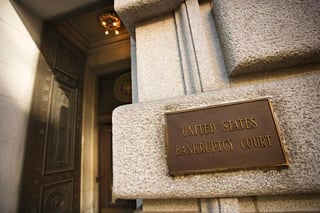 There is a law, in effect in all fifty states of the United States, that allows people who have entered into contracts to borrow money or to receive credit to have their contractual obligations discharged - wiped out - without harsh consequences to the borrower. This is the Bankruptcy law, set out in the U. S. Bankruptcy Code, and at first look it seems to be a very unusual public policy. Don’t we want people to honor their debts? What about the financial well-being of lenders if they run the risk of a government-sanctioned method of allowing people who asked the lender for money with a promise of repayment to break that promise? So where does this policy come from? That’s what we’ll look at in this blog.
There is a law, in effect in all fifty states of the United States, that allows people who have entered into contracts to borrow money or to receive credit to have their contractual obligations discharged - wiped out - without harsh consequences to the borrower. This is the Bankruptcy law, set out in the U. S. Bankruptcy Code, and at first look it seems to be a very unusual public policy. Don’t we want people to honor their debts? What about the financial well-being of lenders if they run the risk of a government-sanctioned method of allowing people who asked the lender for money with a promise of repayment to break that promise? So where does this policy come from? That’s what we’ll look at in this blog.
Old Testament Origins
The concept of debt forgiveness as something that society allows is found in the Old Testament of the Bible. Moses decreed that once every fifty years there would be a “jubilee” - during that year, all debt would be eliminated and any Israelites that had sold themselves into slavery would be freed. The Mosaic jubilee is found in the Book of Leviticus. Later, the Book of Deuteronomy called for a jubilee year once every seven years. With the once every seven years jubilee, lenders were required to cancel all debts owed to them. The Israelites of the Old Testament started the concept of debt forgiveness, as a sign on earth of God’s forgiveness and mercy.
Treatment of Defaulted Debt in Ancient Society
In other cultures, though, such mercy was not common. In ancient societies non-payment of debt resulted in harsh consequences to debtors. In ancient Greece, if an individual was unable to pay his debt, that individual, together with all of the members of his household, became slaves. In some regions of Greece, debt slavery was limited to five years - so even this harsh consequence had some mitigation.
It was none other than Julius Caesar, though, who give the Roman Empire the world’s first recognizable bankruptcy laws. Caesar had been a chronic debtor until he gained dominant military and political power in Rome. It was Caesar who ended the practice of debtors being sold into slavery. Rather than take away personal liberty, Caesar’s law gave creditors the right to seize a debtor’s land to satisfy delinquent debts.
The practical effect of this trade off showed creditors that the most effective way to collect debts was not to strip debtors of everything they owned, and following the enactment of Caesar’s law, eventually more leniency is collection was codified in Roman law, including the concept that debtor’s could retain the tools of their trade and any income-producing property that they owned in connection with their trade. What the Romans found was that it was, in the “big picture” more commercially profitable for more people if defaulting debtors were not financial ruined.
When the Roman Empire fell, Caesar’s law were passed on to Papal bankers, as the Church replaced the Roman Empire as the unifying institution of Europe. The theory of bankruptcy was the same as in Roman times: debtors had land seized from them by their creditors, but they did not lose personal liberty and they were able to retain work-related property to allow them to function in society. After the land was sold, the debtor was relieved of further obligations to his creditor.
During late middle ages the term bankruptcy became common to describe the legal liquidation of a debtor’s assets. The name comes from the Latin words for “broken bench,” and the term was used due to the custom that in Italy, vendors and money lenders, who usually sat at a bench in the public square to do business. If the merchant/lender became insolvent so they could no longer do business, the merchant/lender broke the bench he did business from. From the Latin words “bancus” (bench) and “ruptus” (broken) we get our English word bankruptcy.
Bankruptcy in England
The relatively forgiving Caesarian bankruptcy laws of the Middle Ages became less debtor-friendly as the world entered the Enlightenment. The first English bankruptcy law was passed in 1542 during the reign of Henry VIII. This bankruptcy law was much less forgiving: the debtor, by defaulting on his obligations, was seen as committing a crime - and as such could be imprisoned. This law led to the creation of debtor’s prisons - a feature of debt collection that lasted several centuries, both in England and the United States. The debtor was jailed until such time as the debtor’s family had retired the debt. It wasn’t until the early 18th Century, during the reign of Queen Anne that English bankruptcy law softened. The law was changed that allowed a debtor to have his debt discharged provided the debtor agreed to pay what he could afford to the creditor. Debtor’s prisons still remained, however, for those individuals who weren’t able to pay anything to the creditor. Another option for creditor’s remedies in England was to have the debtor become an “indentured servant” - although this was completely voluntary on the part of the debtor - no creditor could force a debtor into indentured servitude.
Bankruptcy in the United States
Until the Revolutionary War, the 13 colonies along the eastern seaboard that became the United States were colonies of England. As such, English law in the period before independence controlled debtor-creditor relations.
After the Revolutionary War and until the ratification of the Constitution in 1789, each state had the authority to determine its own bankruptcy law. That changed when the Constitution was ratified.. Article 1, Section 8 of the Constitution gave Congress the exclusive right to make “uniform laws on the subject of Bankruptcies.” The intent of the framers of the Constitution was to create uniform commercial law wherever possible, and Bankruptcy law fit into the commercial law system.
Congress, having been given the power to do so, passed its first bankruptcy law in 1800. However, this law only dealt with involuntary bankruptcies - bankruptcy cases that are initiated by creditors against debtors, against the debtor’s wishes.
Voluntary bankruptcy - a case initiated by the debtor - was not legislatively approved until 1841. The early forms of voluntary bankruptcy is what we’ll look at, in detail, next week.


